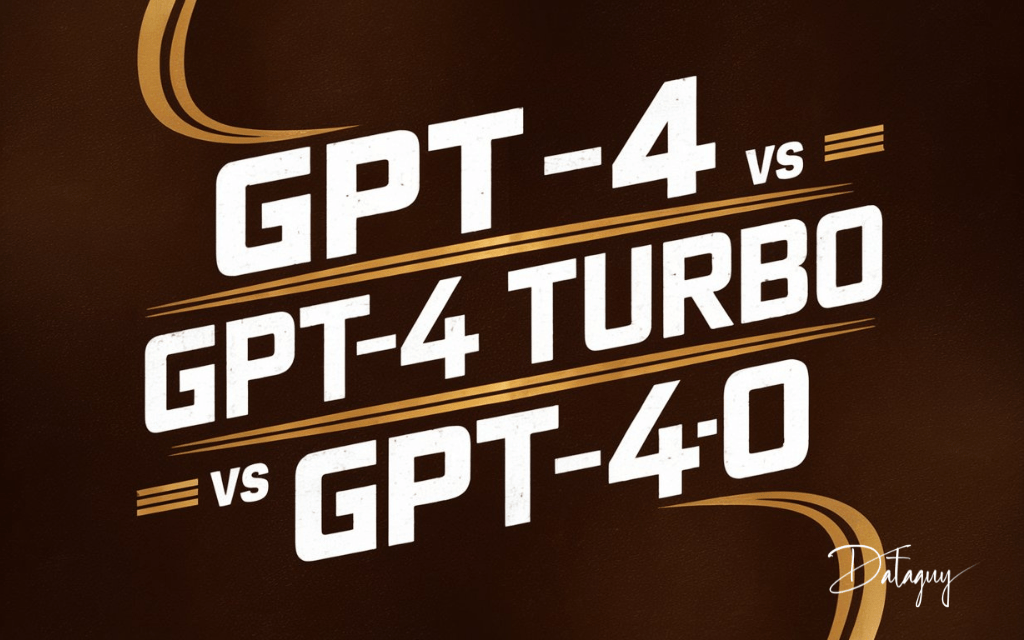Insights Index
ToggleComparing GPT-4, GPT-4 Turbo, and GPT-4o: Key Differences and Benefits
As AI technology advances, understanding the nuances between different models like GPT-4, GPT-4 Turbo, and GPT-4o is crucial for leveraging their full potential.
This blog explores the differences between GPT-4, GPT-4 Turbo, and GPT-4o, highlighting their unique features and benefits. Whether you need cost-efficiency, speed, or advanced capabilities, this guide will help you choose the right AI model for your needs.

What is GPT-4?
GPT-4 is the latest in OpenAI’s series of large language models, known for its advanced natural language understanding and generation capabilities. It excels in a wide range of tasks, from text completion to complex problem-solving.
Key Features of GPT-4
- High Intelligence: GPT-4 is built on a sophisticated architecture that allows it to understand and generate human-like text.
- Context Window: GPT-4 offers a context window of up to 128k tokens, enabling it to handle extensive conversations and complex inputs.
- Versatility: It supports both text and image inputs, making it highly adaptable to various applications.
Introducing GPT-4 Turbo
GPT-4 Turbo is a more efficient and cost-effective version of GPT-4. Designed for users who need high performance without incurring high costs, GPT-4 Turbo maintains the core capabilities of GPT-4 with some optimizations.
Key Differences from GPT-4
- Cost: GPT-4 Turbo is 3X cheaper for input tokens and 2X cheaper for output tokens compared to GPT-4.
- Speed: It is designed to be faster, making it suitable for applications that require quick response times.
- Context Window: Like GPT-4, it supports a 128k token context window.
The New GPT-4o
GPT-4o, or GPT-4 Omni, is the latest iteration designed to be even faster, more affordable, and capable of handling higher loads than its predecessors. It is optimized for both text and vision tasks, with a focus on efficiency and multilingual capabilities.
Key Differences from GPT-4 and GPT-4 Turbo
- Cost: GPT-4o is 50% cheaper than GPT-4 Turbo, making it the most cost-effective option.
- Rate Limits: It offers 5x higher rate limits than GPT-4 Turbo, handling up to 10 million tokens per minute.
- Speed: GPT-4o is 2x faster than GPT-4 Turbo, ensuring rapid response times.
- Vision Capabilities: GPT-4o has enhanced vision capabilities, outperforming GPT-4 Turbo in image-related tasks.
- Multilingual Support: Improved support for non-English languages, making it more versatile globally.
- Context Window: It supports the same 128k token context window, suitable for lengthy and complex inputs.
- Knowledge Cutoff: GPT-4o has an updated knowledge cutoff date of October 2023, ensuring more up-to-date information.
Choosing the Right Model
Selecting the appropriate model depends on your specific needs:
- For Cost Efficiency: GPT-4o is the most economical option.
- For Speed: GPT-4o offers the fastest processing.
- For Extensive Inputs: Both GPT-4 and GPT-4 Turbo support large context windows, but GPT-4o provides better rate limits.
- For Vision Tasks: GPT-4o is the superior choice for tasks involving image inputs.
Conclusion
Understanding the differences between GPT-4, GPT-4 Turbo, and GPT-4o is crucial for leveraging the full potential of AI in your projects. Whether you prioritize cost, speed, or advanced features, there is a model that fits your needs. Explore these models further to enhance your applications and achieve your AI goals effectively.
Visit OpenAI’s official documentation for more details and get started on your next AI project.



